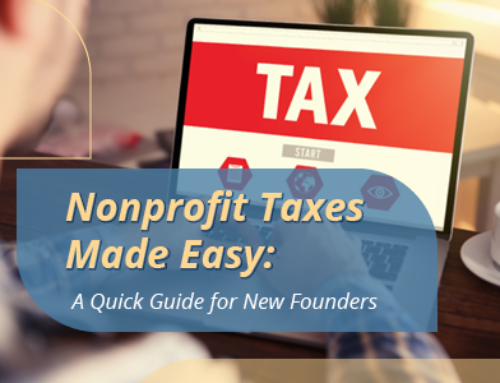
As your nonprofit starts to blossom, don’t be surprised if you are conflicted over how much to spend on nonprofit administration, especially fundraising.
Obviously, donors want as much of their donation as possible to go to your programs, to help change lives.
But you have to spend some money on running your nonprofit. And fundraising.
You may find yourself spending money on the tech tools. The training. The print collateral. The postage. And on and on it goes.
As the costs add up, you might be asking: How much of a nonprofit’s annual budget should be spent on administrative tasks and fundraising?
Here’s the short answer: 15 to 25%.
For your small organization to thrive, you have to spend money on fundraising. Period.
You can’t raise the kind of money you need for free. There WILL be expenses you need to pay for.
Look at it this way: If you’re not spending at least 15% of your budget on fundraising, you may be standing in the way of your own success. (And if you don’t have a budget, that’s an even bigger problem!)
If you are just starting out, you may have to build up to that goal. But your goal should be to spend appropriately on fundraising so you can bring in the money you need to fully fund your programs.
On the other end of the spectrum, if you’re spending more than 25% of your total income on fundraising and administration, your donors may be turned off and stop giving, which means your programs may suffer.
Organizations that overspend on fundraising are often working inefficiently, spending on fundraising strategies that are not getting results.
For example, if you hire a fundraising consultant but that consultant does not succeed in helping your organization raise more money, you will end up overspending on fundraising.
Or, if you rent a list of names and addresses and send a direct mail piece to everyone on that list, you probably won’t recoup enough in donations to make that a worthwhile expense. You may end up at the end of the year having overspent on fundraising. (This is a WHOLE other issue – how to succeed at direct mail fundraising.)
Overspending on fundraising is NOT the problem I see most often in small nonprofits, though. It’s more common for organizations to spend too little, in their desire to be excellent stewards of the money they raise. Many young nonprofits run lean operations, with very little money spent on nonprofit administration, especially fundraising.
They seek out the free version of every tool, look for professional volunteers to do every skilled task pro bono, and stuff their own envelopes for their annual appeal.
Sometimes that’s ok. But if free is a MUST, that’s a problem.
When you aren’t willing to spend any money on fundraising, you can’t implement strategies that are likely to work for your organization and get the traction you need to get your fundraising off the ground.
Extreme frugality is not the answer!
Even if you can proudly tell donors that only 2% of their money went toward fundraising, you won’t be building up your programs because you won’t have enough money coming in.
It’s important to strike the right balance between spending enough money on fundraising to be successful, but not spending too much, especially on strategies that don’t pay off.
Donors want you to spend their money on programs: helping people, rescuing animals, cleaning up the environment, or whatever your nonprofit does. That’s understandable. YOU probably want to spend their money on programs, too!
Your fundraising spending should be the right amount to fully fund your budget without wasting money on ineffective strategies. But what does that look like in practical terms?
Let’s start by looking at what truly qualifies as a fundraising expense. After all, you can’t figure out the right balance for your organization if you don’t know what to categorize as a fundraising expense.
What is Considered Fundraising Spending?
 When you track your nonprofit administration spending, you will have several categories feeding into what is considered overhead, including management, general, and fundraising.
When you track your nonprofit administration spending, you will have several categories feeding into what is considered overhead, including management, general, and fundraising.
These are also known as indirect costs, expenses that cannot be tied directly to programs.
This total should not go over 35%, the cap recommended by the Better Business Bureau here in the U.S. Although the IRS does not have rules on how much a 501c3 can spend on overhead, spending more than 35% on overhead could hurt your credibility and drain funds that should be going toward your programs.
If you’re outside the U.S., check to see what your country’s standards are.
Fundraising expenses include costs you incur when soliciting and securing donations. This includes:
- Staff time attributable to fundraising
- Fees paid to fundraising consultants or outsourced help like a grant writer
- Costs related to specific fundraising campaigns like printing and postage
- Costs of creating and distributing print collateral like paying a graphic designer or mailing materials
- Donor management software and other technology tools used for raising funds
- Expenses related to events
- Fundraising training
- Membership in fundraising organizations
Management and general expenses include activities that don’t map to fundraising or a specific program. These expenses include:
- Oversight and management, including the portion of the salaries of the Executive Director and support staff that are not attributable to fundraising or programs (staff meetings, strategic planning, annual meetings, etc.)
- Bookkeeping and accounting services
- Legal services
- Insurance
Why is Categorizing Expenses so Important?
Categorizing your expenses can be confusing as there are gray areas where expenses could fit into more than one category.
Studies show nonprofits often have different ways of categorizing expenses, with many claiming too much for indirect or overhead costs, while others attribute expenses to programs that should be considered management and general expenses.
The most important thing is to be consistent in how you assign expenses to categories. And make lots of notes so later you can remember why you put certain numbers in certain places.
Consider hiring an accountant to advise you on categorizing your expenses. A bookkeeper can help you set up the right documentation and tracking procedures so you categorize everything consistently and are not stuck trying to figure it all out come tax time.
Here in the U.S., proper documentation and categorizing of expenses is part of the deal you strike with the IRS when you get 501c3 status. The IRS requires transparency in exchange for tax-exempt status.
Here’s a video where I explain how to categorize expenses so you can more easily fund your overhead: https://youtu.be/VzeJvkwSgRg
What About Ratings on Sites Like Charity Navigator?
Fear of getting a bad rating on sites like Charity Navigator keeps many nonprofit leaders from spending money on fundraising.
Charity Navigator wields a lot of influence in the nonprofit sector with its star ratings that take into account how much an organization spends on overhead.
These star ratings can be accessed quickly online and may deter donors from giving. No one wants a two-star or—God forbid—a one-star rating!
Most organizations do NOT need to fear Charity Navigator, though.
Charity Navigator only rates organizations with $1 million or more in revenue for two consecutive years. Most organizations either stay below that benchmark or work up to that size of an operation, allowing time to develop the right processes to accurately categorize expenses and maintain the right overhead expense ratio to get a three- or four-star rating.
Charity Navigator has come under fire for pushing nonprofits into a cycle of self-starvation in order to report low overhead and get a good rating.
Organizations have argued that nonprofits must be able to spend on fundraising and other costs labeled as overhead in order to grow and thrive.
Charity Navigator has adjusted its rating system over the years to be more fair to nonprofits while continuing to expose excessive spending on overhead, especially executive salaries.
Don’t worry about Charity Navigator. Instead focus your energies on determining the right fundraising strategies to fully fund your programs and the right amount to spend to implement those strategies effectively.
Why You SHOULD Spend on Fundraising?

If you are a small nonprofit that spends next to nothing on fundraising, you are hardly alone.
This is very common. No one wants to be judged or called out for spending too much on overhead.
But skimping on fundraising can lead you into a trap of limiting your ability to grow and thrive.
If this is you, think about what is holding you back. Are you afraid of spending on a fundraising strategy that won’t work? Do you want to put 100% of donations toward programs? Do you think you can raise enough to fund your programs without spending any money?
You have to adjust your mindset and convince yourself that spending money on fundraising is a normal part of fundraising. Just like you have to get comfortable asking for money, you have to get comfortable spending money on fundraising.
By spending money on a donor management tool, you will be able to more efficiently process donations and acknowledgments. You will have a better handle on who your donors are, how much they give, and who might be able to give a little more. You will be able to quickly determine who gave last year but hasn’t given yet this year. You will be a much better, much smarter fundraiser!
A direct mail appeal costs money, but a letter sent through the mail can be an essential piece of a successful fundraising program, inviting supporters who prefer to give by check to send in a donation.
An impact report costs money to print and mail, but it tells your top donors exactly how you spent their money. If you never share with your donors how you are spending their money, you risk never getting another donation from them.
If you’re nervous about spending on fundraising, start slow and gradually build in fundraising expenses that will give you a good return on your investment while keeping all your general operating expenses under 35%. Many organizations aim for 20% of their funds to be spent on non-program expenses, and this is a wonderful goal. You have to figure out the right goal for your organization.
It’s nice to be able to tell donors that 95 cents of every dollar they donate will go toward programs, but it’s not necessary to be successful. Focus on your successful programs, your wonderful outcomes, the difference you are making in the lives of others, the animals you are rescuing. This is what inspires donors to give!
If a donor asks what percent of your budget goes to overhead, state the answer clearly and without apology. “We spend 20% of our budget on overhead, as that is what it takes for us to operate at maximum efficiency and maintain our programs.”
Donors will respect this answer. And, many will be impressed that you know the answer off the top of your head! This will give you instant credibility.
Then, steer the conversation back to your programs. “Let me tell you about a graduate of our program who is doing phenomenally in college!”
Don’t Go Overboard on Fundraising Spending
At the other end of the spectrum are organizations that overspend on fundraising while chasing every new idea and hoping against hope that something will land.
I don’t have to tell you this is a disastrous strategy. If this is you, pull back on your fundraising spending for a minute.
Focus on one signature event, 10 grant proposals, and 1,000 new donors each year. This is a proven strategy that will help you build up your fundraising without wasting money on events and strategies that aren’t right for your organization.
Another problem arises when organizations give the appearance of spending a lot on fundraising. This could be off-putting and cost you some supporters.
Here are some ways you might be suggesting to donors that you spend a lot on fundraising:
When building up your fundraising, keep a close eye on spending. Spend every dollar strategically, so that you are making a good investment. Focus on proven strategies for retaining the supporters you have and gaining new supporters.
Don’t get taken in by shiny, new things in fundraising. It’s the tried-and-true strategies that will get you where you want to go.
The Bottom Line

Organizations suffer when they spend too little on fundraising and when they spend too much. Focus your nonprofit administration on getting your fundraising spending right where it needs to be to get you where you want to go.
Analyze every fundraising strategy you implement to determine the ROI or Return on Investment. Did that annual appeal you send through the mail perform well? Did your backyard barbecue raise significantly more than you spent?
Don’t starve your organization in an effort to divert every penny of your donations to programs. This will stifle your growth while you chase a goal that most donors do not expect you to achieve.
Seek out the sweet spot where you are spending enough on fundraising to implement your strategies and sustain them over time, but you’re not overspending on solutions and shortcuts that don’t pay off.
Then look for ways to spend that will pay off and help you raise more money and change more lives. Because that’s what it’s all about!





Thank you for this article; the issue is really important. I do think that your comment about hiring a fundraising consultant needs further clarification. I am a fundraising consultant (not a fundraiser). Therefore, when I work with nonprofits I am providing them with the tools they need to be successful (e.g., helping to develop comprehensive development plans, guide them on their utility, etc.). The development professional’s success is not directly tied to the expenses the nonprofit pays me to consult. It is their responsibility, and the responsibility of those who manage the development professional, to ensure success. In other words, I wouldn’t consider the consultant’s cost “overspending” because the development professional doesn’t hit their targets.